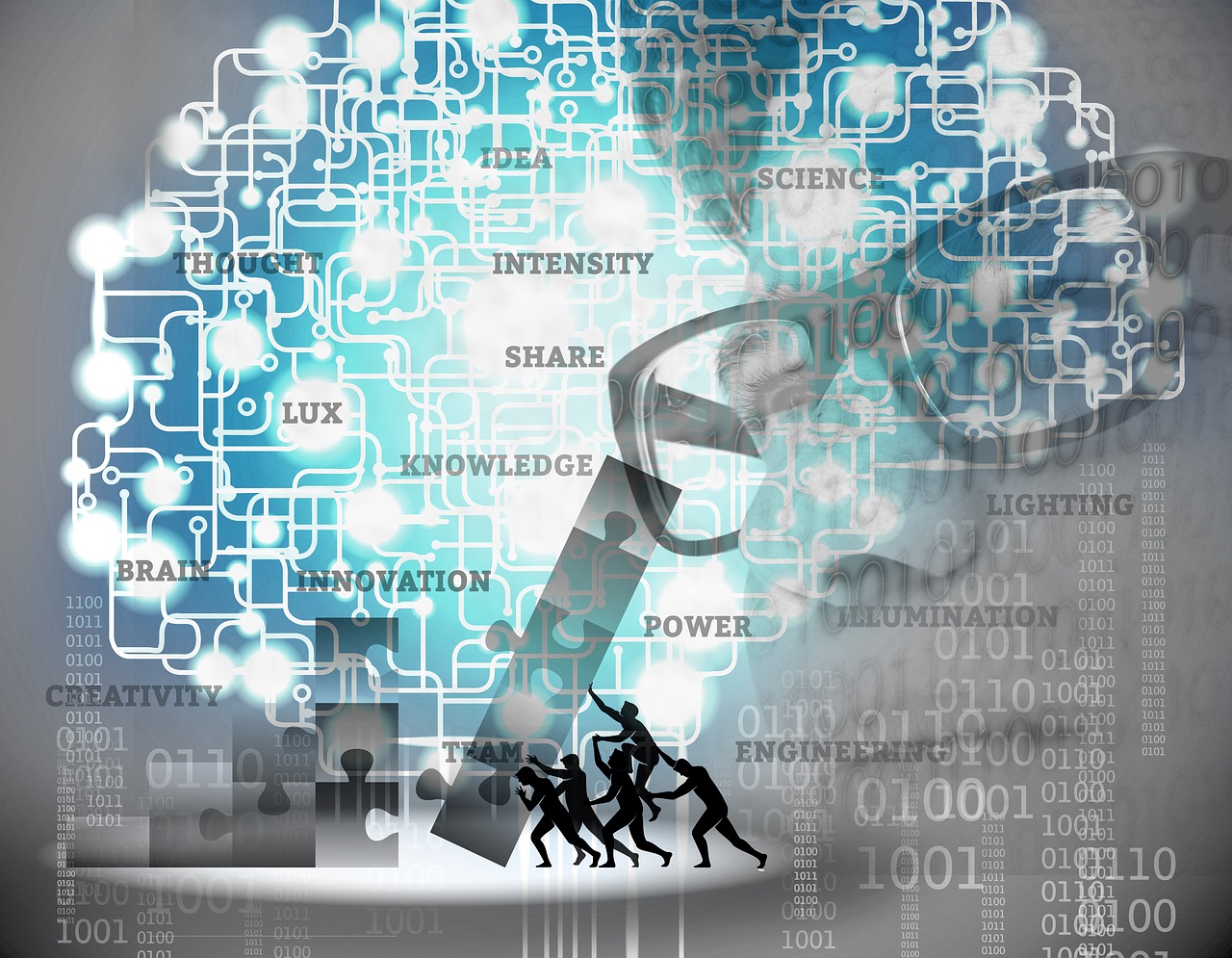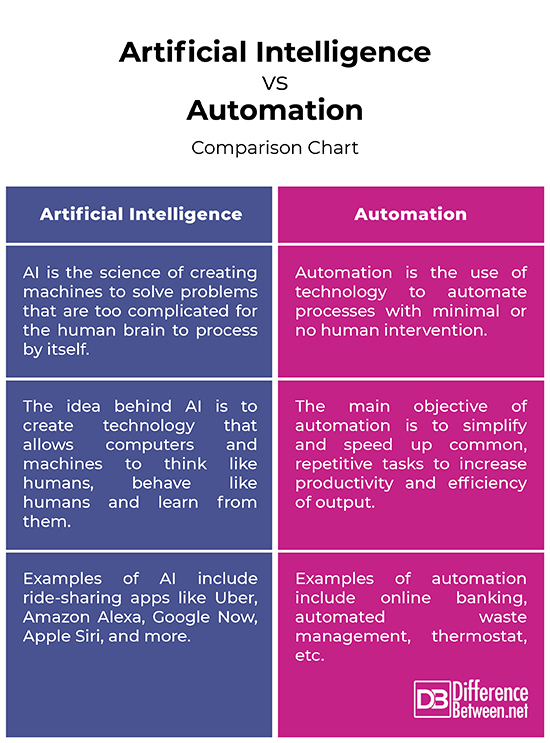Difference Between AI and Automation
The rise of artificial intelligence is the biggest groundbreaking story of our time. What once was a dream is now the future of mankind; decades into the making, AI has infused itself into many aspects of our lives: our phones, our cars, the way we shop, and the way we choose our music. AI is almost all around us, embedded in many higher-order pursuits. Well, machines are getting smarter every day and doing more and more. Technological breakthroughs like automation and artificial intelligence gradually removed inconvenience, making things simpler and solving the everyday problems that we faced earlier. Transactions, for one, now happen much faster, cheaper, and more accurately than before.
Perhaps the most significant development in the technology space is automation. And artificial intelligence is the cornerstone of this new, more sophisticated style of automation. AI and automation are transforming businesses around the world by contributing to productivity. But both the terms AI and automation are often used interchangeably in a way they are often confused with each other. Both the terms are synonymous with smart machines that are making our days just a bit easier and more fun. Despite everything, AI and automation are two different things. Let’s take a look at the two.
What is Artificial Intelligence?
Artificial Intelligence, commonly referred to just as “AI”, is the science of creating machines that are tasked to solve problems and accomplish some work that is too complicated for the human brain to process by itself. AI is an effort to make computers think like humans, creating machines with minds, in the full and literal sense. AI is not science fiction, but real science, based on the concept of intelligent machines. The concept of AI is not new; some of the examples are what you might have already seen in movies like planes without pilots, cars without drivers, robots doing work, etc. Well, there are other examples of artificial intelligence that are so common and familiar that you might not even notice them, such as the computers we use every day, satellite TV, the smartphones we use every minute of every day, and even the gaming console. They are all examples of AI in action and we probably know nothing.
What is Automation?
Automation, as the name suggests, is the use of technology to automate processes with minimal or no human intervention. Automation is all about making machines capable enough of doing monotonous tasks automatically and effectively. Automation is not a new concept. What new is the limitless abilities of machines to attain automation? It is the ability of machines to perform tasks that would otherwise be impossible or difficult when performed by humans. Automation is everywhere. Any device or machine that operates autonomously is an automated system. There are numerous real-life examples of automation you come across every day such as payment apps, thermostats, coffee makers, an ATM machine, automated parking systems, automated machine assembly, shopping apps, and so much more. Automation is all upon us, but it’s hidden. Automated systems can be generally classified as fixed automation and programmable automation.
Difference between AI and Automation
Terminology
– Both the terms artificial intelligence (AI) and automation are often used interchangeably. However, they are two different terms. AI is the science of creating machines that are tasked to solve problems and accomplish some tasks that are too complicated for the human brain to process by itself. Automation, on the other hand, is the use of technology to automate processes with minimal or no human intervention. Automation is the ability of machines to perform tasks that would otherwise be impossible or difficult when performed by humans whereas AI is the simulation of human intelligence.
Objective
– AI focuses on creating highly intelligent machines to accomplish tasks that in normal sense would be called intelligent thinking or behavior. It is the science and engineering of making machines smart enough to mimic human intelligence and behavior. The idea behind AI is to create technology that allows computers and machines to think like humans, behave like humans and learn from them. The main objective of automation is to simplify and speed up common, repetitive tasks to increase productivity and efficiency of output, with less or no human involvement.
Examples
– Examples of artificial intelligence include ride-sharing apps like Uber and Lyft, speech recognition, problem-solving, machine learning, smart email categorization, spam filters, Amazon Alexa devices, Chatbots, Apple’s Siri, Google Now, Internet of Things, Google Predictive searching, Product recommendations, and more.
Examples of automation include form auto-filling, customer support, digital signatures, automatic assembling, employee analytics, online banking, payment processing, numerical control machines, material handling robots, highway systems, automated waste management, automated retail, video surveillance, etc. One of the common examples of an automated system is a thermostat used on household appliances.
Artificial Intelligence vs. Automation: Comparison Chart
Summary of Artificial Intelligence vs. Automation
When we think about how technology has revolutionized everything and impacted our lives, we see technologies like automation and artificial intelligence becoming the dominant form of intelligence and immersing themselves in our environments. It’s true that AI has transitioned from being our daily helper to something much more powerful, as the new automated systems are rapidly outperforming the smartest of us in many endeavors. Technology is about exploring possibilities and this is exactly what AI and automation are all about – exploring new possibilities to outsmart human intelligence. That being said, AI is about making machines smart enough to supersede human’s intelligence and behavior, whereas automation is to simplify and speed up processes without human intervention.
- Difference Between Caucus and Primary - June 18, 2024
- Difference Between PPO and POS - May 30, 2024
- Difference Between RFID and NFC - May 28, 2024
Search DifferenceBetween.net :
Leave a Response
References :
[0]Image credit: https://pixabay.com/de/illustrations/automatisierung-ingenieure-technik-2710335/
[1]Image credit: https://pixabay.com/de/illustrations/k%C3%BCnstliche-intelligenz-gehirn-hirn-3382507/
[2]Frank, Malcolm, et al. What To Do When Machines Do Everything. Hoboken, New Jersey: John Wiley & Sons, 2017. Print
[3]Danner, George E. The Executive's How-To Guide to Automation: Mastering AI and Algorithm-Driven Business. Berlin, Germany: Springer, 2018. Print
[4]Haugeland, John. Artificial Intelligence: The Very Idea. Cambridge, Massachusetts: MIT Press, 1989. Print



